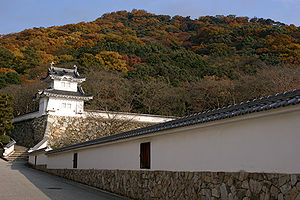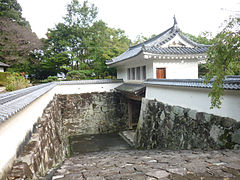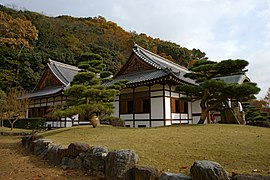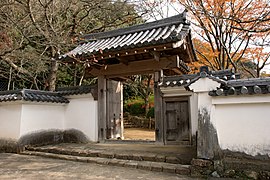Tatsuno Castle
| Tatsuno Castle | ||
|---|---|---|
|
Tatsuno Castle |
||
| Castle type : | Hirajiro (Lower Castle) | |
| Conservation status: | Partly preserved, partly reconstructed | |
| Place: | Tatsuno | |
| Geographical location | 34 ° 52 '7.7 " N , 134 ° 32' 41.4" E | |
|
|
||
The Castle Tatsuno ( Japanese 龍野城 , Tatsuno-jō ) is located in the city of Tatsuno in the prefecture of Hyogo . In the Edo period , the Wakizaka last resided there as medium-sized Tozama daimyō from Tatsuno with an income of 53,000 koku , namely at the end of the Edo period: larger parts of the districts of Ittō and Issai and some villages from the Shikisai-gun (together approx the area of today's cities of Tatsuno, Taishi and a western strip of Himeji) in the province of Harima as well as parts of several counties of the province of Mimasaka .
Lords of the castle in the Edo period
- From 1617 a branch of the Honda with 50,000 Koku,
- from 1626 a branch of the Ogasawara with 60,000 koku,
- from 1633 the okabe with 50,000 koku,
- from 1637 a branch of Kyōgoku with 60,000 Koku and
- from 1672 the Wakizaka with 53,000 Koku.
history
Tatsuno Castle is said to have been created by Akamatsu Murahide (赤松 邨 秀) in 1499 on Mount Keirō (鶏 籠 山). In 1581, Toyotomi Hideyoshi's vassals Hachisuka Masakatsu (蜂 須 賀正勝, 1526–1586), Kinoshita Katsutoshi (木 下 勝俊, 1569–1649) and Koide Yoshimasa (小 出 吉 政, 1565–1613) got the castle until the big changes after the Battle of Sekigahara came. During this time the castle was given a modern look.
After the Battle of Sekigahara, the lords of the castle changed at short intervals until Wakizaka Yasumasa (脇 坂 安 政, 1633–1694) became lord of the castle. He put on a new castle at the foot of the Keirō, with walls, moats, watchtowers and a residence, but a little modest for a medium-sized daimyō with 53,000 koku income.
The attachment
Because space was limited, the secondary residence (上 屋 敷, Kamiyashiki) was built on the slope above the main residence. The preserved building for the tea ceremony, called Jūentei (聚 遠 邸), received the 9th Daimyō Wakizaka Yasuori (脇 坂 安 宅; 1809–1874) from Emperor Kōmei , who had it moved here for his great service as administrator of the city of Kyoto.
In 1979 the Tamamon watchtower (多 門 櫓), the Uzumi gate (埋 門), implemented as a small two-story gate (櫓 門, Yaguramon), a two-story watchtower and the residence as a replica, and walls and moats were restored so that one get a good impression of the castle complex. In addition to the tea house mentioned, the associated gardens have also been preserved. - Most of the castle grounds are used by public institutions today. The Museum of the History of the City of Tatsuno (た つ の 市立 龍 野 歴 史 文化 資料 館, Tatsuno shiritsu Tatsuno rekishibunka shirōykan) is also located there.
photos
Remarks
- ↑ Although the Wakizaka Tozama daimyō were, they were also commissioned several times by the shogunate with tasks. The second lord of the castle, Wakizaka Yasuteru (脇 坂 安 照; 1658-1722), was entrusted in 1702 after the incident with Asano Naganori (see the 47 Rōnin ) with the supervision of the Akō castle. The eighth lord of the castle, Wakizaka Yasutada (脇 坂 安 薫), held the position of Rōjū in the shogunate, as did the already mentioned Wakizaka Yasutaka.
literature
- Kato, Masafumi: Tatsuno-jo in: Miura, Masayuki (Ed.): Shiro to jinya. Saikoku-hen. Gakken, 2006. ISBN 978-4-05-604379-2 .
Web links
- ↑ National Museum of Japanese History : 旧 高 旧 領取 調帳 デ ー タ ベ ー ス (database of domains and income at the end of the shogunate) based on the series of publications of the same name (Kimura Motoi: 旧 高 旧 領取 調帳 , 6 vols., Kondō Shuppansha 1969-79), search mask , Entries for the 竜 野 藩 (sic, not 龍 野 藩 !)
- ↑ Hyōgo prefecture administration : materials on the history, list of principalities with seat or property in today's Hyōgo and map of the ruled areas at the end of the shogunate (Japanese), Tatsuno-han in pink










